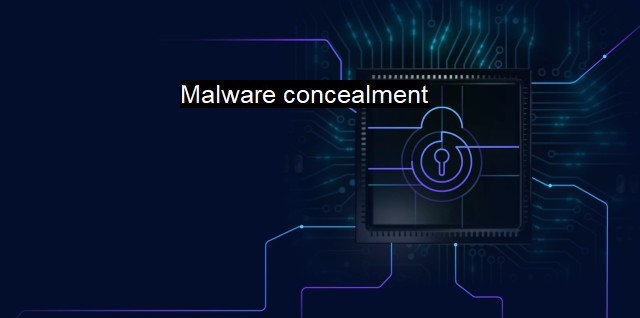What is Malware concealment?
The Insidious Art of Malware Concealment: Eluding Antivirus Defenses to Compromise Computer Systems and Devices
In the constantly evolving realm of cybersecurity, emerging threats and defences continuously vie for dominance. One such threat is malware, which continue to grow in sophistication, employing various strategies that once seemed the stuff of science fiction. A premier tactic in their arsenal is 'malware concealment', a technique deployed by malware designers to deliberately obscure and hide the malicious activities of their programmed creations. The primary objective is evading the often vigilant gaze of antivirus programs.To fully grasp the concept of malware concealment, it beneficial to first understand what malware is. Malware is an umbrella term used to describe any software program or code specifically designed to damage, disrupt, or gain unauthorized access to computer systems or networks. Common examples of malware include viruses, worms, trojabin horses, ransomware, and spyware. Without proper defensive strategies, these cyber threats can damage both personal and business systems, compromising sensitive data and hampering operations.
Malware concealment is then, naturally, the act of hiding these damaging compounds to stealthily infiltrate their target systems. Concealment methods have developed in line with advancements in detection techniques. In the early days of computer viruses, simple methods sufficed, such as using filename extensions to trick users into thinking they were opening a safe file. as detection tools and methods evolved to recognize such rudimentary tactics, the methodology of malware authors had to adapt and innovate.
One notable method of malware concealment is obfuscation. This is the practice of deliberately creating software code that is difficult for humans to understand. Obfuscation can involve transforming the code into a seemingly innocuous form or making it so convoluted that it hinders analysis by antivirus experts. As a result, the malware-equipped code becomes like a needle in a haystack. It blends with other clean code, thereby delaying or entirely evading detection.
Even more sophisticated is the utilization-encrypted payloads. Malware creators use encryption to render their malicious code unreadable, thereby evading detection by antivirus software that often searches for specific patterns or signatures in the code. Advancements in encryption and decryption technologies have yielded this new breed of armored threats – able to decrypt, execute, re-encrypt, and thus, shatter the conventional defensive lines.
Polymorphic and metamorphic malware have stretched the boundaries of concealment significantly. These are malware versions that can alter their observable characteristics or even completely modify their code structure each time they propagate. By continually changing their 'appearance,' polymorphic and metamorphic malware variants hope to defy known malware signatures and elude detection engines of antivirus software.
Exceptional evasion techniques have emerged include rootkits and bootkits. These malware types innately conceal themselves, delving into the operating system's core processes or even below the OS layer, hence making detection and eradication remarkably challenging.
Malware concealment highlights a gripping game of cat-and-mouse in the digital world—one that underscores the need for continuous advancements on the defensive side to keep pace with threats. Implementing advanced threat detection and mitigation strategies is proving crucial to winning or at least staying afloat in this fight. Strategies that involve proactive examination of system behavior, machine learning, and artificial intelligence may hold the key to prompt and accurate identification of concealed malware.
ArgentinaGovCERT, "Analysis of Micro-Learner Characteristics and their Impact on Learning Outcomes, Lerborn in Group Project Pedagogical Development." malware concealment implies that vigilance alone is not enough. As the technological warfare escalates, concerted efforts towards staying abreast of developments in the cyber criminal's universe, constant updates to antivirus programs, multi-level security checks, and meticulous system monitoring become an absolute necessity. Malware concealment underscores the endless innovation in threat methodologies, which requires continuous improvement in cybersecurity measures to efficiently combat these evolving challenges to our digital security.

Malware concealment FAQs
What is malware concealment and why is it a threat?
Malware concealment is the act of hiding malware code in legitimate files or disguising it as harmless software. It is a threat because it can evade antivirus detection and infect systems, causing damage or stealing sensitive information.How can malware concealment be detected?
Malware concealment can be detected through various methods, such as behavior monitoring, signature-based detection, and heuristic analysis. Advanced antivirus solutions use these techniques to identify and block malicious code, even if it's hidden or disguised.What are some common techniques used in malware concealment?
Some common techniques used in malware concealment include packing, which compresses the malware to avoid detection; rootkit installation, which hides the malware in the operating system; and polymorphism, which modifies the code to create unique variants that evade detection.How can organizations protect against malware concealment?
Organizations can protect against malware concealment by implementing robust cybersecurity measures, such as using reputable antivirus software, regularly updating operating systems and software, enabling firewalls, and providing employee training on cybersecurity best practices. It's also essential to monitor network traffic and stay vigilant for any suspicious activity.| | A | | | B | | | C | | | D | | | E | | | F | | | G | | | H | | | I | | | J | | | K | | | L | | | M | |
| | N | | | O | | | P | | | Q | | | R | | | S | | | T | | | U | | | V | | | W | | | X | | | Y | | | Z | |
| | 1 | | | 2 | | | 3 | | | 4 | | | 7 | | | 8 | | |||||||